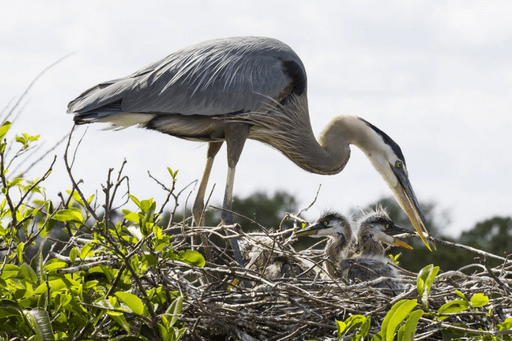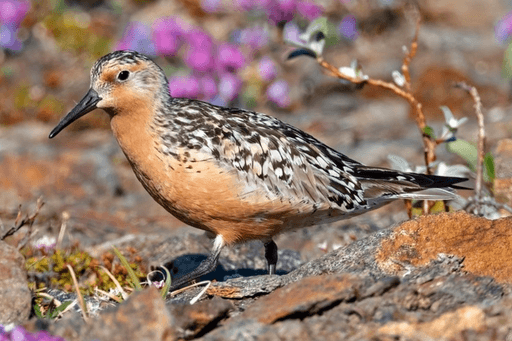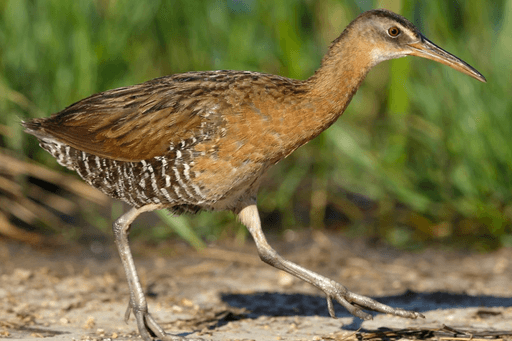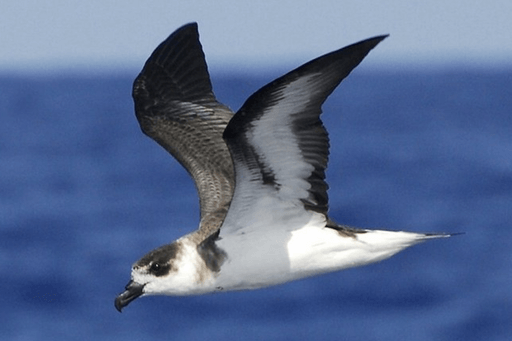Birds of Virginia: Waterbirds
Waterbirds are among Virginia's superlative birds, including some of the largest (pelicans and swans), most colorful (ducks), most ornamentally plumed (egrets and herons), and most exciting to watch (skimmers skimming, terns diving, ibises flapping over marshes at sunrise or sunset). Most are great flyers and many are migratory.
Given these abilities, rare waterbirds from distant regions also pop up in Virginia from time to time. Here are just a few of the “wacky” vagrants that have turned up in Virginia in recent years: Mottled Duck (usually not found north of South Carolina); Pink-footed Goose (nearest nesting in Greenland and Iceland); Garganey (a small duck from Eurasia); Northern Lapwing (a shorebird that nests in Eurasia); and European Storm-Petrel.
Although ducks and swans in general are doing well, shorebirds, seabirds, and others are among the most rapidly declining bird groups. Climate change, increasingly severe weather events, and rising seas pose formidable challenges to conserving waterbirds that use sensitive coastal habitats.
This post is part of a five-part series in which we look at some of our favorite bird groups in Virginia (backyard birds, grassland birds, raptors, and forest birds) by profiling some of the most captivating species in each.
Swans

Virginia boasts a diverse array of waterfowl, especially in winter, when many species flee frozen water to the north to winter in Virginia's wetlands and along its coasts. Huge flocks of Snow Geese provide a winter spectacle along the Delmarva Peninsula, while large numbers of Black, Surf, and White-winged Scoters can be seen flying in skeins offshore. In late spring, Wood Ducks nest in tree cavities and nest boxes. The American Black Duck is a regional endemic present year-round. An entire blog could be devoted to Virginia waterfowl, but here we only have space to highlight one group: Swans are the largest of all waterfowl, and two native species can be observed regularly in Virginia. The Trumpeter Swan is our largest, and the Tundra Swan is our most abundant. (The introduced Mute Swan is also present year-round in some areas.)
Locations: Tundra Swans are best viewed in winter at coastal reserves like Back Bay National Wildlife Refuge, and during their migration in early spring up the Potomac River from sites such as Elizabeth Hartwell Mason Neck National Wildlife Refuge. Since they often migrate overland at night, keep an ear out and you might even hear or see Tundra Swans flying over your yard! Trumpeter Swans are relatively scarce in Virginia but are appearing in increasing numbers thanks to decades of reintroduction efforts. They are best viewed in Fauquier County at the Airlie Center and Clifton Institute, where many are resident and wear numbered neck collars. Uncollared offspring and other individuals sometimes join these groups.
Conservation: As a group, waterfowl are among the best conservation success stories, as noted in the 2019 Science article on bird declines authored by ABC and other partners. This recovery was driven by conservation investments funded by hunters, and by billions of dollars of government funding for wetland protection and restoration. The Trumpeter Swan population numbered more than 63,000 wild birds in 2015, up from 15,630 wild birds in 1991, according to the Birds of the World online account. Lead poisoning remains a threat to waterbirds like loons and swans, as evidenced by a Trumpeter Swan rehabilitated in Virginia in 2013. ABC has long advocated for better policies to reduce the poisoning of wildlife, including Trumpeter Swans, due to ingestion of lead-based ammunition and fishing tackle.
Great Blue Heron

The Great Blue Heron is one of our most widespread and iconic waterbirds. Sometimes confused with the Sandhill Crane, this fierce predator hunts by wading into shallow water, standing still, then striking at fish, frogs, and other prey with its spear-like bill.
Locations: Great Blue Herons are widespread throughout Virginia and can be seen in most wetlands and along the coasts, as well as flying overhead almost anywhere, as they commute to colony sites, roosts, or foraging areas. In Northern Virginia, Burke Lake Park supports a large breeding colony visible across the lake from the boat ramp. Chincoteague National Wildlife Refuge is another favorite spot to see this species and other wading birds. The pure-white subspecies known as the Great White Heron, which nests in South Florida and the Caribbean, has been observed in Virginia a couple of times, with eBird records in 2002 and 2017.
Conservation: The Great Blue Heron population is robust and slowly growing, estimated at around 700,000 across its range, according to Partners in Flight. The Great White Heron is estimated to number 1,000 to 2,500 mature individuals across its range, according to the International Union for Conservation of Nature (which considers it a separate species classified as Endangered).
Red Knot

The Red Knot is a large sandpiper that breeds in the Arctic. The rufa subspecies is a real globe-trotter, nesting on tundra, migrating along North America's Atlantic coast, and wintering along the coasts of southern South America, northern Brazil, the Caribbean, and U.S. Gulf states. One of the most important parts of this population's epic migration occurs in spring, when most birds stop for several weeks along the shores of Delaware Bay in Delaware and New Jersey to feast on Atlantic Horseshoe Crab (Limulus polyphemus) eggs. This high-protein food source enables these birds to gain enough weight and energy stores to continue on to the Arctic and quickly start breeding. Other critical stopover sites are in Virginia, primarily along the Eastern Shore's barrier island chain, where these birds feed on Coquina Clams (Donax variabilis) and Blue Mussel (Mytilus edulis) spat.
Locations: Red Knots can be found on open beaches along the coast of Virginia, primarily in spring and fall, but they are scarce at other times of year. Barrier island beaches such as those at Back Bay National Wildlife Refuge and Assateague National Seashore (and sometimes coastal flats at adjacent Chincoteague National Wildlife Refuge) are good places to search for this species.
Conservation: The rufa population of the Red Knot is in trouble, with only 6,880 counted in May 2021 in the Delaware Bay. This is much reduced from the 19,000 counted in 2020 and 30,000 counted in 2018 and 2019, and is the lowest number recorded since counting began in 1982, when 95,530 were estimated. The recent decline may be related to a lack of Atlantic Horseshoe Crab eggs on the beaches of Delaware Bay in 2020, when unusually cold ocean temperatures delayed spawning.
In 2021, horseshoe crab eggs were plentiful, but an overall shortage on beaches is suspected in the Red Knot's long-term decline. Humans have harvested horseshoe crabs for fertilizer, livestock feed, and for their blue blood, which is used to test drugs and medical devices for contamination. Beginning in the 1980s, horseshoe crabs were commercially harvested in unsustainable numbers for conch and eel bait, which fueled steep declines of both this invertebrate and Red Knots. In 2015, the rufa population of Red Knot was listed as Threatened under the U.S. Endangered Species Act. ABC, which is a member of the Horseshoe Crab Recovery Coalition, was instrumental in advocating for this listing.
ABC has also successfully advocated for horseshoe crab harvest restrictions in Mid-Atlantic states and for the creation of a horseshoe crab sanctuary at the mouth of Delaware Bay. New Jersey has, for 12 years running, maintained a moratorium on horseshoe crab harvests, while Delaware, Maryland, and Virginia now ban capture of females, and now shut down the harvest season once a quota is reached on males. While declines in horseshoe crab populations have certainly contributed to the declining rufa population, other factors need to be examined, such as the impacts of climate change on food availability on the knot's Arctic breeding grounds.
Piping Plover

The Piping Plover is the color of sand, nests on sand, and forages on sand. Although often hard to spot, this beautiful and scarce bird is always a thrill to see (from a respectable distance). Piping Plovers breed in small numbers on beaches along the Atlantic Coast and Great Lakes, and also on alkali flats in the interior of the continent. They winter on beaches and mudflats in the southern U.S. and the Caribbean.
Locations: Piping Plovers can be found on open beaches near dunes from about March to October in Virginia. Assateague National Seashore (adjacent to Chincoteague National Wildlife Refuge) is a great place to find them, often near the beach parking lot. Back Bay National Wildlife Refuge is another great place to look for this species. For the sake of these sensitive birds, please heed all posted warnings to keep distant from marked nesting areas.
Conservation: Piping Plovers breeding in the Great Lakes are listed as Endangered under the U.S. Endangered Species Act, and the interior and Atlantic populations are listed as Threatened. The global population numbers about 8,000 birds. Critical Piping Plover nesting habitats are now protected to help the species during its breeding season. Populations have seen significant increases since protection programs began, but the species remains in danger. For example, at popular Jones Beach near New York City, nesting Piping Plovers were threatened by a colony of feral cats, until the cat colony was removed in 2019 thanks to advocacy by ABC. ABC is also leading a Gulf Coast conservation effort that is working to identify and implement protective measures for vulnerable beach-nesting birds and other birds, such as the Piping Plover, that winter there. Strategies include preservation of plover habitats; public education; limiting off-road vehicle traffic; and reducing predation by addressing the dangers of free-roaming cats and dogs. With support from the Environmental Protection Agency, ABC and partners also launched SPLASh (Stopping Plastics and Litter Along Shorelines) on the Texas coast in 2020, working with partners to remove huge amounts of plastic and other trash pollution that threaten Piping Plovers and other birds that rely on sand beaches and dunes. SPLASh also has a substantial public education component aimed at reducing these contaminants over time.
Royal Tern

Royal Terns are among the largest terns in Virginia, second in size only to the Caspian Tern. Virginia sits near the northern edge of the species' breeding range. Royal Terns nest colonially and prefer sandy islands that are safe from potential predators. North American populations migrate south to winter along coasts from the southeastern United States to South America.
Locations: Virginia's largest colony of seabirds, including Royal Terns, was at South Island. As you'll read below, due to recent construction, birds from this colony relocated to nearby Fort Wool. Although the colony is not accessible to the public, the Hampton Roads Bridge-Tunnel passes right by it, and these terns can be viewed flying to and from the colony from publicly accessible vantage points at nearby Fort Monroe (although the colony itself is not visible from there). Fortunately, Royal Terns (including birds banded at Fort Wool) can be seen widely along Virginia's Atlantic beaches, the Chesapeake Bay, and up the major rivers, particularly in late summer when birds disperse from breeding locations.
Conservation: Royal Tern populations declined significantly in the late 1800s and early 1900s, when people collected the birds' eggs as food. Although populations made a comeback in the 20th century, new threats arose, particularly loss of habitat due to barrier island development.
Royal Terns are sensitive to disturbance at their nesting colonies and may abandon them if people, dogs, or other predators approach too closely. Construction work for the expanded Hampton Roads Bridge-Tunnel threatened the state's largest colony of Royal Terns and Sandwich Terns, along with other nesters including about 10 percent of the state's breeding Gull-billed and Common Terns, Black Skimmers, and Laughing Gulls. In 2019, ABC and partners urged action by the state to save the colony. Virginia consulted with multiple stakeholders and the result: a successful relocation.
Luckily, the Royal Tern readily accepts artificial dredge-spoil islands as alternate nesting sites. Virginia's Department of Wildlife Resources (DWR) worked with the Virginia Department of Transportation to lay sand and gravel at nearby Fort Wool (Rip Raps Island, adjacent to South Island), to control rats there, and to moor substrate-covered barges nearby. In spring, returning birds were drawn to new sites thanks in part to playback and decoys deployed by Virginia Tech biologists, work partly funded by ABC. By late summer, thousands of birds were at the new colony sites. Data analysis revealed that the “class of 2020” included an estimated 10,452 adult Royal Terns and approximately 5,200 chicks at Fort Wool, along with an estimated 236 adult Sandwich Terns with approximately 118 chicks, hundreds of Laughing Gulls, and about 18 Common Tern adults nesting apart from the Royal and Sandwich Terns. On the nearby barges, researchers counted more than 800 adult Common Terns with more than 700 chicks; at least 140 adult Black Skimmers with approximately 130 chicks; and a single pair of state-threatened Gull-billed Terns with two chicks (Virginia Tech, unpublished data). In 2021, the colony was again teeming, and preliminary results suggest the numbers of breeding terns and skimmers exceeded the 2020 estimates, including adult Gull-billed Terns, which rose from a single pair to 30 birds. DWR's website on the project provides ongoing updates on the project.
Rails

Have you ever heard the expression “thin as a rail”? Well, this refers to birds — the rails — which can make themselves extra skinny as they skulk between marsh grasses. Several species of rails occur in Virginia, including the Clapper Rail, King Rail, Virginia Rail, Sora, Black Rail, and Yellow Rail. Rails are considered game birds, with a regulated hunting season in the state. The most widespread rail species in the state may be the namesake Virginia Rail. The easiest rail to see, however, is probably the Clapper Rail. A denizen of our coastal saltmarshes, the Clapper Rail is both highly vocal and fairly bold, sometimes exiting marsh vegetation at low tide to wander mudflats and muddy channels.
Locations: Rails can show up almost anywhere during migration. A good place to look (and listen) for Clapper and Virginia Rails is Saxis Wildlife Management Area. Queen Sound Landing and Chincoteague National Wildlife Refuge are among many possible coastal spots for Clapper Rail. King Rails are more limited in Virginia, with Occoquan Bay National Wildlife Refuge being a reliable spot in Northern Virginia in recent years, but most other areas are located in extreme southeastern Virginia, including False Cape State Park, Back Bay National Wildlife Refuge, and Princess Anne Wildlife Management Area. Although there are widespread reports of Sora across the state, these tend to be concentrated along the coasts in the east and in wetlands in intermountain valleys on the state's west side. Marshes with wild rice attract Sora during their fall migration, with sites along the Chickahominy River hosting high seasonal concentrations of the species. Black Rails were once more readily heard in Virginia — and elsewhere in the United States — but this tiny, elusive bird has since declined dramatically. In fact, eBird does not publicly disclose Black Rail locations in the U.S. since this species is deemed sensitive to potential disturbance. Yellow Rails are usually considered rare vagrants in Virginia, but in the spring of 2021, several were heard calling from the Marsh Trail at Chincoteague National Wildlife Refuge.
Conservation: King Rail populations have declined 86 percent in North America over the past 50 years due to loss of wetland habitat. The eastern Black Rail population (which is listed as Endangered in Virginia) has declined by more than 90 percent along the Atlantic Coast since the 1990s, and is undergoing evaluation to be listed under the U.S. Endangered Species Act, a designation ABC supports. Recent declines in the Black Rail population are likely caused by the rapid loss of high-marsh breeding habitat from sea level rise, and other factors. The Atlantic Coast Joint Venture is a partnership between private organizations (including ABC) and government agencies working hard to coordinate conservation efforts for coastal marshes and marshland species including the Black Rail, American Black Duck, and Saltmarsh Sparrow. ABC is working to support efforts from North Carolina to Georgia to create marsh habitats that meet the very specific needs of Black Rails and that are not subject to inundation from sea level rise.
Black-capped Petrel

No list of Virginia waterbirds would be complete without mentioning pelagic birds, those mostly seen far offshore on the open sea. For instance, alcids such as the Razorbill migrate south to Virginia's Atlantic Coast in some winters. Pelagic boat trips off Virginia Beach can offer birders opportunities to see jaegers, skuas, shearwaters, and many other species rarely viewed from land. One of the most difficult-to-find and mysterious pelagic birds to regularly course into Virginia's waters is the Black-capped Petrel — which is also one of the species of most concern to conservationists. Black-capped Petrels spend most of their lives at sea, and come to land only to nest. Their breeding sites are hidden in rugged Caribbean mountains on Hispaniola (with possible nest sites on islands such as Dominica yet to be confirmed). From there, they range out over the Caribbean Sea and Gulf of Mexico, south to the northern coast of South America, and north up the Gulf Stream as far north as the Mid-Atlantic. The Black-capped Petrel has two color morphs (white-faced and dark-faced), which appear to molt during different seasons, suggesting that they breed at different times and may even be different species. Much is left to learn about these “little devils,” nicknamed for their haunting nocturnal vocalizations at Caribbean nesting areas.
Locations: Black-capped Petrels are rarely seen in Virginia, but are most frequently observed on pelagic trips out of Virginia Beach in May and September. Sometimes these birds are forced closer to shore or even inland during hurricanes or other strong storms. For example, many birders observed Black-capped Petrels and other pelagic species from the Chesapeake Bay Bridge Tunnel during stormy times in September 2003 and September 2016.
Conservation: This species is listed as Endangered globally, its population estimated at fewer than 1,000 pairs. Black-capped Petrels are most threatened at their breeding sites, where adults and chicks are killed by introduced predators, and their habitat is threatened by forest conversion and fires. Elsewhere, artificial lights may disorient these birds, leading to collisions with wires or buildings, while at sea, petrels may face additional hazards, including offshore energy development. In May 2019, ABC brought together an international team of seabird experts to capture Black-capped Petrels at sea for the first time. The team, composed of U.S. Geological Survey (USGS) scientists, New Zealand experts, and U.S. conservationists, equipped the endangered birds with satellite transmitters. This research advanced our understanding of where these birds travel, and tracked a white-faced morph bird back to Hispaniola, offering the first evidence of this form possibly nesting there. ABC also works with partners like Grupo Jaragua in the Dominican Republic to find and protect nesting sites.
We hope you enjoyed this blog post about Virginia waterbirds. We recommend the following as additional resources for bird-watching information specific to Virginia:
- Virginia Bird & Wildlife Trail, an organized network of outdoor sites highlighting the best places to see birds and wildlife in the commonwealth.
- Second Virginia Breeding Bird Atlas (eBird Portal) ebird.org/atlasva/home (Note: A free eBird account is required to view these maps/data.)
- Virginia Society of Ornithology www.virginiabirds.org.
- Northern Virginia Bird Club www.nvabc.org.
- Birding Virginia for birding site information with profiles on birding hotspots and counties.
- A Birder's Guide to Virginia, by David W. Johnston, 1999, American Birding Association.
Authors
Daniel Lebbin, Vice President of Threatened Species, American Bird Conservancy; Sergio Harding, Nongame Bird Conservation Biologist, Virginia Department of Wildlife Resources; Ashley Peele, Avian Ecologist, Conservation Management Institute, Department of Fisheries and Wildlife Conservation, Virginia Tech; Becky Keller, Science Coordinator, Appalachian Mountains Joint Venture, American Bird Conservancy; EJ Williams, Vice President, Southeast Region, American Bird Conservancy
Thanks also to Lindsey Troutman, Craig Watson, Ruth Boettcher, Kirsten Luke, Jeff Larkin, Jen Davis, Andrés Anchondo, Peter Dieser, David Wiedenfeld, George Wallace, and the Appalachian Mountains Joint Venture Team (Elizabeth Brewer, Amanda Duren, and Jessica Wise) for their suggestions and edits to this blog series.


















































